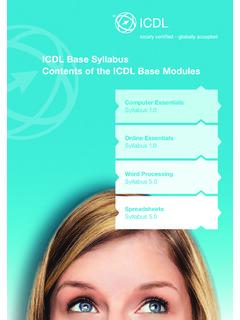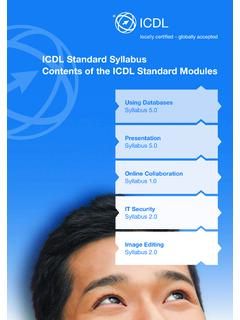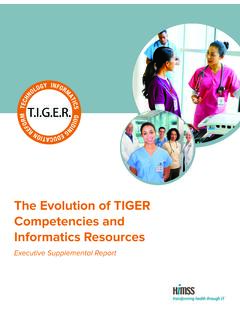Transcription of ICDL Standard Syllabus Contents ICDL Module IT Security
1 icdl Standard SyllabusContents icdl Module IT SecurityIT SecuritySyllabus Services (Switzerland) abethenanlage 7CH-4051 BaslePhone +41 61 270 88 77 Fax +41 61 270 88 2016 PSI Services (Switzerland) rights publication may only be used in connection with the ECDL / icdl Services (Switzerland) Inc. has taken great care in the preparation of this publication, but can give no warranty for the completeness or accuracy of the informatio n contained within itnor shall they be liable for any possible damages arising from this information. In case of doubt the version of the ECDL Foundation published at can find the online version of this icdl Syllabus at IT Security How to use your computer, tablet and smartphone safelyThis icdl sylla bus describes the knowledge you need to pass the icdl IT Security exam.
2 You can also use this booklet as a checklist to find out which skills you still need to skills you will acquire from the Module IT Security will allow you to safely use modern informati on and communication technology: you will know how to maintain a secure network connectio n, encrypt e-mails and drives as well as be aware of the possible dangers of using the Internet. You will also understand the risks of using mobile devices and cloud storage and will be able to protect your privacy onli obtain an icdl Standard certificate you need to pass all four Base modules and three Standard modules of your choice, IT Security . Most icdl Test Centres offer courses for these icdl modules.
3 You can take the corresponding exams at any one of about 300 icdl Test Centres in Switzerland, whether you attended a course there or information on the advanced certificates, icdl Advanced and icdl Expert, as well as an overview of all icdl Test Centres is available on our website. Our online shop offers a range of courseware to help you prepare for the icdl exams. Julia van WijnkoopManaging DirectorPSI Services (Switzerland) Modules and CertificatesStandard ModulesUsing DatabasesPresentationOnline CollaborationIT SecurityImage EditingAdvanced ModulesWord ProcessingSpreadsheetsDatabasePresentati onComputer EssentialsBase ModulesOnline EssentialsWord ProcessingSpreadsheetsICDL Advanced CertificateICDL Expert Certificate1 Advanced Module of your choice 3 Advanced modules of your choiceICDL Base Certificate4 Base modulesICDL Standard Certificate4 Base modules+ 3 Standard modules of your choice5IT SecurityIT SecurityThis Module sets out concepts relating to the secure use of ICT in daily life and skills used to maintain a secure network connection.
4 Use the Internet safely and securely, and manage data and information appropriately. Module Goals Successful candidates will be able to:} Understand the importance of keeping information and data secure, and identify common data /privacy protection, retention and control principles} Recognise threats to personal Security from identity theft and potential threats to data from using cloud computing} Use passwords and encryption to secure files and data} Understand the threat of malware and be able to protect a computer, device or network from malware and address malware attacks} Recognise common network and wireless Security types and be able to use personal firewalls and personal hotspots} Protect a computer or device from unauthorised access and be able to safely manage and update passwords} Use appropriate web browser settings and understand how to authenticate websites and browse the web securely} Understand communication Security issues that can arise from using e-mail, social networks, voice over Internet protocol.
5 Instant messaging and mobile devices} Back up and restore data to local and cloud storage locations and delete and dispose of data and devices securelyCategoryKnowledge Item1 | Security | Data between data and the terms cybercrime, malicious, accidental threats to data from individuals, service providers, external threats to data from extraordinary circumstances like: fire, floods, war, threats to data from using cloud computing like: data control, potential loss of privacy6IT SecurityCategoryKnowledge | Value of basic characteristics of information Security like: confidentiality, integrity, the reasons for protecting personal information like: avoiding identity theft, fraud, maintaining the reasons for protecting workplace information on computers and devices like: preventing theft, fraudulent use, accidental data loss, common data /privacy protection, retention and control principles like.
6 Transparency, legitimate purposes, the terms data subjects and data controllers and how data /privacy protection, retention and control principles apply to the importance of adhering to guidelines and policies for ICT use and how to access | Personal the term social engineering and its implications like: unauthorised computer and device access, unauthorised information gathering, methods of social engineering like: phone calls, phishing, shoulder the term identity theft and its implications: personal, financial, business, methods of identity theft like: information diving, skimming, | File the effect of enabling /disabling macro Security the advantages, limitations of encryption.
7 Be aware of the importance of not disclosing or losing the encryption password, key, a file, folder, a password for files like: documents, spreadsheets, compressed filesIT Security7 CategoryKnowledge Item2 | | Types and the term malware. Recognise different ways that malware can be concealed on computers and devices like: Trojans, rootkits, types of infectious malware and understand how they work like: viruses, types of data theft, profit generating /extortion malware and understand how they work like: adware, ransomware, spyware, bot- nets, keystroke logging, | how anti-virus software works and its that anti-virus software should be installed on computers and the importance of regularly updating software like: anti-virus, web browser, plug-in, application, operating specific drives, folders, files using anti-virus software.
8 Schedule scans using anti-virus the risks of using obsolete and unsupported software like: increased malware threats, | Resolving and the term quarantine and the effect of quarantining infected /suspicious , delete infected /suspicious that a malware attack can be diagnosed and resolved using online resources like: websites of operating system, anti-virus, web browser software providers, websites of relevant authorities3 | Network | Networks and the term network and recognise the common network types like: local area network (LAN), wireless local area network (WLAN), wide area network (WAN), virtual private network (VPN) how connecting to a network has implications for Security like: malware, unauthorised data access, maintaining privacy8IT SecurityCategoryKnowledge the role of the network administrator in managing authentication, authorisation and accounting, monitoring and installing relevant Security patches and updates, monitoring network traffic, and in dealing with malware found within a the function, limitations of a firewall in personal, work a personal firewall on, off.
9 Allow, block an application, service / feature access through a personal | Wireless different options for wireless Security and their limitations like: Wired Equivalent Privacy ( WEP), Wi-Fi Protected Access ( WPA)/ Wi-Fi Protected Access 2 ( WPA2), Media Access Control ( MAC) filtering, Service Set Identifier ( SSID ) that using an unprotected wireless network can lead to attacks like: eavesdroppers, network hijacking, man in the the term personal , disable a secure personal hotspot, and securely connect, disconnect devices4 | Access | measures for preventing unauthorised access to data like: user name, password, PIN, encryption, multi-factor the term one-time password and its typical the purpose of a network that a network account should be accessed through a user name and password and locked, logged off when not in common biometric Security techniques used in access control like: fingerprint, eye scanning, face recognition, hand | Password good password policies, like.
10 Adequate password length, adequate letter, number and special characters mix, not sharing passwords, changing them regularly, different passwords for different servicesIT Security9 CategoryKnowledge the function, limitations of pass-word manager software5 | Secure Web Use | Browser appropriate settings for enabling, disabling autocomplete, autosave when completing a private data from a browser like: browsing history, download history, cached Internet files, passwords, cookies, auto-complete | Secure aware that certain online activity (purchasing, banking) should only be undertaken on secure web pages using a secure network ways to confirm the authenticity of a website like: content quality, currency, valid URL, company or owner information, contact information, Security certificate, validating domain the term the function and types of content-control software like.



